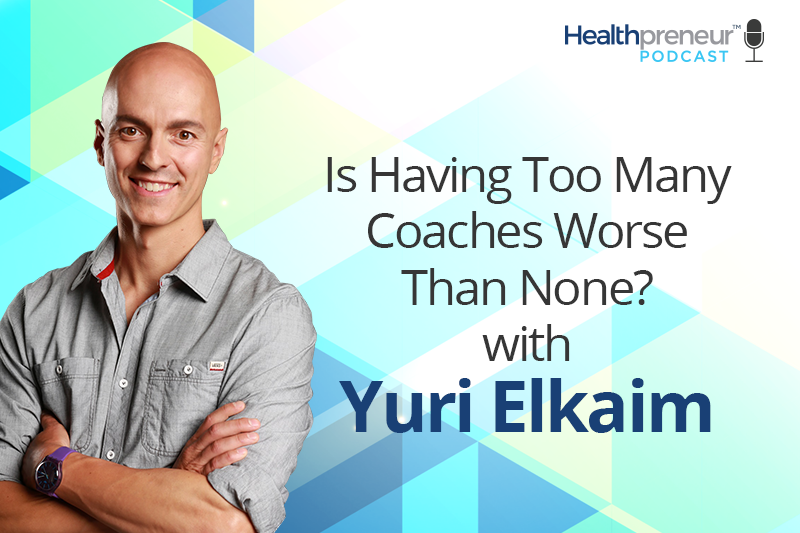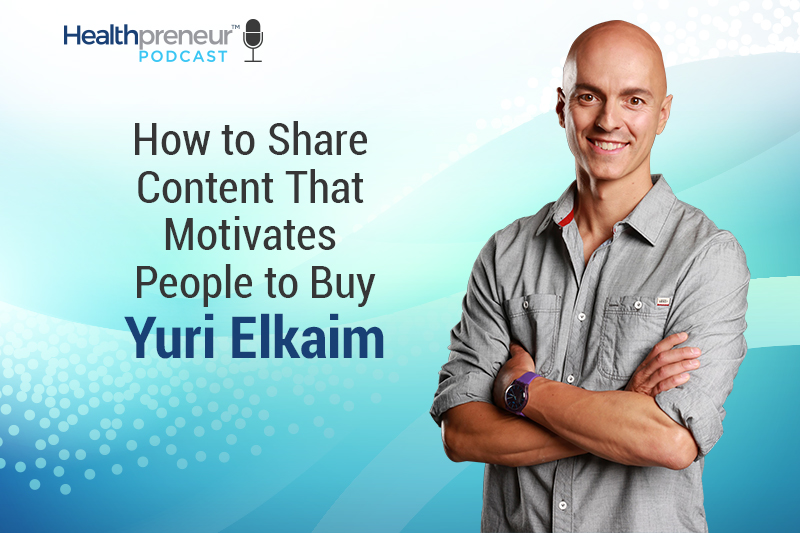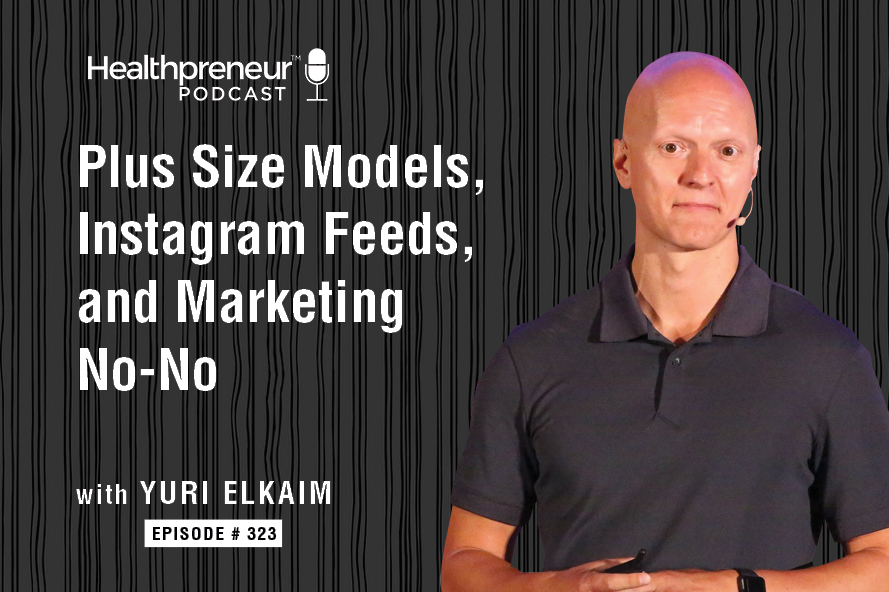No One Cares About Your Thing
What’s up Healthpreneurs! In today’s episode we’re talking about the sixth Client Activator. This is the final of the three activators in the message pillar. This activator is called empathy. Your messaging needs to be empathetic.
Why? Because No One Cares About Your Thing
All too often, one of the biggest mistakes people make with their messaging is making your message all about you, your story, and/or your offer. It screams self-promotion. This is rampant in the health, wellness, and fitness space.
Truth be told, no one cares.
Tune in to find out how to craft a message catered to empathize with your prospects they will care about, sit up and take notice of.
In This Episode I discuss:
02:00 – 03:50 – It’s Not About You
03:50 – 05:10 – The Dilemma Of Being An Expert
05:10 – 08:08 – It’s All About Them
08:08 – 12:20 – Tune Into WIIFM
12:20 – 13:45 – Wrap Up With Yuri
Transcription
Welcome back to the show. Let me tell you a really long story about my life. Now, just before you turn the power button off because you’re probably thinking to yourself, “Dude, I don’t care about your life. Just tell me the goods. Just tell me what you got to tell me that’s going to benefit me.” Well, that’s the core message I want to share with you in today’s episode. We’re talking about the sixth Client Activator. This is the final of the three activators in the message pillar. This activator is called empathetic. Your messaging needs to be empathetic.
The previous two episodes, we talked about your message needing to be vivid. In the prior one to that, we looked at why your messaging needs to be clear, and this final one is your messaging needs to be empathetic.
So clear, vivid, and empathetic. Those are the three activators in the message pillar. For instance, on the worst side of the spectrum… Again, if you don’t have the Scorecard yet, go on over to healthpreneurgroup.com/scorecard. Download this bad boy today. Get your score. See where the leaks are. I’ll show you how to fix them.
It’s Not About You
If we look at the worst side of the spectrum in terms of the empathy side of things, the statement says your message is all about you, your story, and/or your offer. It screams self-promotion. This is rampant in the health, wellness, and fitness space. “I’ve got this amazing thing. I’ve spent so many hours developing it. It’s got 500 videos,” and I don’t care. It’s really sad, but no one cares.
I learned this the hard way. Seven years ago, I built a program called Super Nutrition Academy, which was amazing, I thought. I spent a thousand hours building a nutrition education platform, pretty much, for the average person. We actually built out a certification. You can get CEUs on it, the whole bit. It’s like going back to nutrition school, but for the average person. I took all the stuff that people need to know around nutrition, distilled it down. It was research-backed, but still very simple. That became the course. A thousand hours, I built this thing, and I’m thinking it’s the best thing since sliced bread.
The whole promise was like it’s a four-year college degree in nutrition in one hour per week. Pretty cool promise, but no one cares about learning stuff. They just want to lose weight. We’ll talk about the magic in the next three episodes. When we come to making an offer, that would’ve been nice to know back in the day.
Anyways, had I known this stuff back then, I would’ve saved myself a lot of time, but one of the things I see a lot of people do is what I did. I was so excited about it because I spent so much time doing it, and we get so close and wrapped up in our own stuff that we forget that no one cares about our stuff. What they care about is their problem. That’s really important.
The Dilemma Of Being An Expert
I was speaking to a lady on the phone a couple months ago. She was recommended to me from someone else, and she said she had a book out. I said, “What’s the book all about?” She’s like, “It’s everything I’ve ever learned. It’s 600 pages.” I’m like, “Who is it for?” “It’s for everyone. I talk with protocols for every single condition.” I’m like, “Shit. This is going to be a tough one to sell.”
The reality is, as I’m listening to her talk, it was all about her. It was all about her and her knowledge and her expertise. This is a very slippery slope that as an expert you can slide down very quickly. This is the dilemma of being an expert is that you get so caught up in your expertise that you forget what problem you’re solving. It’s almost like we just want to verbal diarrhea everything we know and assume people want it.
The reality is they don’t. They don’t. People have a problem like, “I have 40 pounds to lose. Just give me a frigging pill. I don’t care how the body works. I don’t care how digestion impacts leptin and… Just tell me the pill or tell me what to do, and I’m going to do it. Everything else, maybe down the road I’ll learn that, but for now, I just want the results.”
It’s All About Them
Your message needs to be catered to empathizing with your prospects. If we look at the far right end of the spectrum on the Scorecard, the statement says, “Your message is centered around your prospect’s major fear, frustration, or desire. You’ve shown the ability to imagine what they might be thinking, feeling, or experiencing. They feel like you are in their head.”
When you hear people talk about, “I watched your thing or I read your thing, and it felt like you were in my head,” that is when you know your messaging is dialed in because if you do this properly, you’re naturally incorporating clarity and vividness in your message, and when it’s emphatic, people can see themselves, the key word is see themselves in that message and that story.
What I just read to you is essentially the encapsulation of a really powerful message is it talks about the fears, frustrations, or desires of your perfect client and not about you. Now, you can share your story and share it in a way where the client sees themselves in your journey. This is actually one of the secrets to running Facebook ads is you can’t say, “Looking to lose weight? Can’t lose those last 20 pounds?” You can’t say that stuff because Facebook will shut you down because it’s just against their policies of making people feel bad. How do we get around that? Well, part of it is sharing your story. You share your story in such a way where the random people on their newsfeed are like, “Man, that’s exactly what I’m going through. That’s exactly what’s going on in my life.”
It’s not about, “Hey, I’m so cool. I did all this cool stuff,” da, da, da, da, da. It’s you’re painting a picture of the prospect, but you might be sharing it through your story, or if you’re not on Facebook ads and you’re just walking on video or you’re writing a message that’s going out in email, it’s all about them.
My first mastermind class, Amanda, Amanda Tress runs Faster Way to Fat Loss, doing more than a million dollars a month, huge business. When we first started working together, I was looking at her initial web page for Faster Way to Fat Loss, and one of the first things I noticed was that the first, I don’t know, one-third of the entire page was all about the prospect. You know why? You know how I knew that? Every single sentence started with the word “you.” “You are here because,” inserts desire or whatever. “You’ve done your best to da, da, da, da, da.” “You’ve tried everything to without,” and it just went on and on. I’m like, “That’s the way to do it. That’s why people resonate with it.”
Tune Into WIIFM
But on the flip side, I see websites that are, “I do this. I’m an expert on this. I da, da, da.” Everyone’s like, “Who cares. Who cares. You’re cool. Whatever. Tell me what you… How am I being helped here?” Remember, the only radio station you should be tuning into is WIIFM. That’s what your prospects are tuned into, so you need to get on the same wavelength. WIIFM stands for What’s In It For Me. Everything you do is about them. Yes, you can share story, but just always, always, always, just keep this in mind. It’s like, am I talking about myself all the time here? Have I gone off on a 20-minute tangent about my own stuff, or is it all about them?
I think this comes back to social cues. One of my best friends from when I was young, we don’t see each other that much anymore, but when we do, it’s the same story he keeps telling over and over and over again. He has pulled more from the past than he has to the future, and that’s why I don’t hang out with him too much.
By the way, you want to be hanging out with people who are pulled towards the future more than pulled toward the past, but here’s the thing is that if we’re at a gathering, barbecue, dinner, whatever… everyone knows him. We’re all good friends. It’s like, “Dude, don’t tell us that same story about whoever or that time in Texas when this happened because we’ve all heard it,” but the funny thing is, he doesn’t get it. He doesn’t clue into the social cues of people being like, “I got to go to the bathroom,” or they’re going to pick up their phone when no one’s called them and fake answer their phone just to get out of the conversation. Don’t be that person who doesn’t pick up on the social cues. Be the person who is obsessed with understanding of what your market is going through.
I shot a video a while ago called The One-Word Marketing Plan. The one-word marketing plan is empathy. If all of your marketing is based around what your perfect clients are going through, you’re doing a pretty good job. I think that that’s important to think about because if your stuff is being put out into the marketplace and no one’s responding to it, well, it could be that they just don’t see what’s in it for them, so empathy is really, really important. How do you do this?
Well, here’s the good thing is that health, fitness, wellness experts usually come when they’re… so when you’re building a business online, you’ve probably already got some degree of experience coaching clients offline. When I started online, I’d been training and seeing clients for seven years in person. Do I need to run surveys? No. Dude. You’ve got seven years of face-to-face client interaction.
Now, if you have zero idea what your clients are dealing with, then that’s on you. Maybe you should show a bit of interest in what they’re going through, what are the challenges that… what’s keeping them up at night? You got to jot this stuff down, man. You got to keep notes on this stuff because everything that comes out of their mouth is marketing gold.
We’re not using it in a way to manipulate people. We’re just saying, “Tell me what you’re going through. Tell me what you’re struggling with. Tell me what’s going on in your head? What’s keeping you up at night? Where do you want to be five years from now? What do you want to see when you look in the mirror?” All of this stuff, this is like human-to-human interaction type stuff. You see, most Internet marketers have zero background in those types of interactions, and therefore, they’re having to figure out “what do my clients want because I don’t even know them,” so they’re running surveys and doing all sorts of stuff.
But you have an unfair advantage just for coming from a clinical setting where you worked with patients or you have your own gym or you just saw people virtually one-on-one on Zoom for instance. Hey, that’s all the intel you need assuming you’ve gotten deep enough to find the intel. That becomes the foundation of all of your messaging. I promise you if you build your messaging around your clients, everything’s going to change in your business.
Wrap Up With Yuri
That is empathy with respect to the message pillar. Next three episodes, we’re going to finish up this whole talk about the Client Activator Scorecard. We’re going to go into the magic, which is the final pillar of this triad of influence, that’s what I call it, market, message, magic.
As I’ve mentioned before, if you don’t have all nine activators, so each pillar has three activators, if all nine of the activators are not dialed in, your messaging, not, sorry, not just your messaging, but your conversions ultimately are going to suffer.
The next three episodes, I mean, I can’t say they’re more important because every single one of the things we talked about is very important, but these next three episodes are probably where I see people drop the ball the most. It comes down to the magic. What is the magic? Well, we’ll talk about that in the next episode.
For now, if you haven’t downloaded the Scorecard, head on over to healthpreneurgroup.com/scorecard. Download it, fill it in, get your score, attend the Deep Dive Training. That’s a free bonus for you that goes along with the Scorecard.
For now, thanks so much for tuning in. I hope this makes sense. I look forward to seeing you in the next episode where we’re going to dive into the third pillar called magic. We’ll start looking at the first activator in that pillar to help you make your offers much more compelling. I’ll see you then.
If you enjoyed this episode, head on over to iTunes and subscribe to Healthpreneur™ Podcast if you haven’t done so already.
While you’re there, leave a rating and review. It really helps us out to reach more people because that is what we’re here to do.
What You Missed
In our last episode, I got to share with you one of my favorite analogies to explain the fourth client activator which I call, The Black Box Analogy.
If you’re just joining us, we’ve been talking about the client activator scorecard, which is a new two page tool we’ve developed to help you improve your conversions, to get more clients and make more money. If you haven’t downloaded your copy you can do so over at healthpreneurgroup.com/scorecard.
In the last three episodes, we’ve talked about the market pillar and the three activators within that. So remember, there’s three pillars, market, message, and magic. Each of those pillars has three activators to help you turn cold leads into high paying clients.
Related posts
August 17, 2018
From 20,000 Patients Per Year to 20,000 Per Day with Dr. Stephen Cabral
Welcome back to the…
February 14, 2020
Plus Size Models, Instagram Feeds, and Marketing No-No
In this episode I want to talk…





